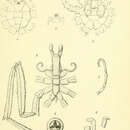Comprehensive Description
provided by Smithsonian Contributions to Zoology
Achelia shepherd. Stock*
Achelia shepherdi Stock, 1973b:92–95, figs. 1–2.
MATERIAL EXAMINED.—One male, 2 females, 5 juveniles, Cheyne Beach, near East Albany, wash of littoral rocks and attached algae, coll. S. Slack-Smith, 6 December 1968, Sta. 2.
One female, SW of Garden Island, S of Fremantle, on algae and gorgonian, coll. R. Slack-Smith, diving, 16 December 1964.
DESCRIPTION.—Trunk circular, compact, unsegmented, lateral processes and neck contiguous. Neck with 2 small setae over each palp insertion. Lateral processes with low dorsodistal tubercles,1 on anterior processes, 2 each on other lateral processes, each armed with short spine. Ocular tubercle low, conical, with small posterior and larger anterior tubercle at tip, both shorter than ocular tubercle. Proboscis extremely large, bulbous or barrel-shaped, tapering to truncate oral surface.Abdomen long, extending beyond first coxa, carried horizontally, armed with 2 dorsal and 2 lateral spines near tip.
Chelifores slender, scape with small dorsodistal tubercle, armed with 1–2 lateral spines. Chela a small angular nub, armed with 2–3 short spines.
Palp 8-segmented, segment 2 longest, armed with 2 dorsodistal setae. Segment 3 almost as wide as long, armed with 1 dorsal seta. Fifth segment only slightly shorter than third, armed with 5 dorsal setae and several small ventral setae. Terminal 4 segments marked by large ventral lobes, longer than twice diameter of segments, armed with strong dorsal, lateral, and ventral spines equal to or greater than segment diameter, and few scattered small setae.
Oviger 10-segmented, fourth and fifth segments subequal and longest. Second segment armed with 4–5 short spines, third armed with 2 reversed spines, and fourth with 1 proximal reversed spine and 1 distal regular spine. Fifth segment without spines. Sixth segment armed with 1 short reversed spine and several longer spines. Seventh with short lateral extension or tubercle, armed with several spines equal to or longer than segment diameter. Terminal 3 segments carried synaxially, but curved in relation to seventh. Eighth segment armed with 1 long endal seta and 1 ectal denticulate spine, ninth with 1 denticulate spine, and tenth, a knob with 2 denticulate spines. Denticulate spines with 6–7 serrations per edge. Female oviger smaller, without seventh segment tubercle. Four terminal segments each armed with 2 denticulate spines.
Legs short, robust, spinose. Coxa 1 with distal rim of 5–6 small tubercles, each bearing single short spine. Coxa 2 with genital process, only longer than half diameter of segment, on last 2 pairs of legs, armed with distal tuft of setae. Coxa 3 with 1–2 dorsal setae and several ventral setae. Femur inflated, setose, with large dorsodistal tubercle bearing few setae and femoral cement gland slightly proximal to apex, arising from tiny tube. Tibia 1 inflated distally, sparsely setose, with several dorsal and lateral tubercles, some bearing spines (others broken off?). Tibia 2 with slight median inflation, setose, several dorsal and lateral tubercles, also with and without spines. Tarsus armed with 6 ventral setae. Propodus moderately curved, without pronounced heel, armed with 2 large spines at heel, 5–6 sole spines distally, and several lateral setae, with 12–13 dorsal setae. Claw extremely robust, less than half propodus length. Auxiliary claws small, less than one-third claw length.
MEASUREMENTS (in mm).—Trunk length (rim ocular segment to tip 4th lateral process), 1.09. Trunk width (across 2nd lateral processes), 1.13. Proboscis length (ventral), 1.05. Abdomen length, 0.57. Third leg: Coxa 1, 0.22; coxa 2, 0.36; coxa 3, 0.24; femur, 0.61; tibia 1, 0.49; tibia 2, 0.42; tarsus, 0.09; propodus, 0.54; claw, 0.23.
- bibliographic citation
- Child, C. Allan. 1975. "Pycnogonida of Western Australia." Smithsonian Contributions to Zoology. 1-28. https://doi.org/10.5479/si.00810282.190
Classification
provided by World Register of Marine Species
In Hayward & Ryland (1990) is this genus placed under the family Acheliidae. We follow ITIS database.
Vanhoutte, Liesbet
- license
- cc-by-4.0
- copyright
- WoRMS Editorial Board

